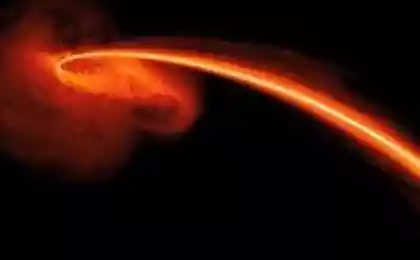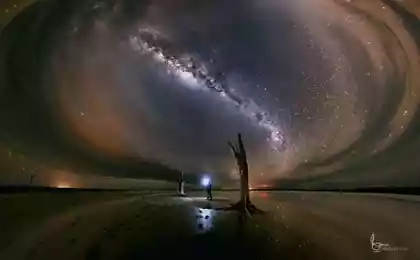432
Supermassive black hole in the galaxy PDS 456 allocates the energy of a trillion suns
Twenty one million nine hundred fifty six thousand three hundred ninety
Giant black hole produced by cosmic wind, which can change the fate of an entire galaxy. Using two x-ray telescopes had detected a uniform distribution of hot gases from a supermassive black hole at the center of galaxy PDS 456, located at a distance of more than 2 billion light-years from Earth. Astronomers have seen similar winds before, but the authors of the new study say that for the first time watched the wind that spread from the center of the hole in all directions, form a sphere.
The wind can exert a strong influence on the fate of PDS 456. According to scientists, it can reduce "food resources" of the black hole and slow down the processes of zvezdoobrazovaniya in the rest of the galaxy. It is possible that strong cosmic winds are an integral part of the evolution of galaxies — they may be responsible for the "aging" of galaxies.
A supermassive black hole at the center of PDS 456 is currently eating up a huge amount of matter: gas and dust is drawn into the gravitational funnel of a black hole. Infall of matter into a black hole releases a tremendous amount of light, which outshines all stars in the galaxy. Such a bright young galaxies called quasars.
New observations of PDS 456 have revealed a bubble of gas emerging from the black hole. Using orbital telescopes NASA's NuSTAR and XMM-Newton of the European space Agency, scientists photographed the galaxy in the period from 2013 to 2014. A new study has shown that the photons emitted by the ingested matter, along with surrounding gas, creating a space wind.
According to scientists, a study published in the journal Science, demonstrates an interesting feature of the behavior of black holes – previously it was thought that the emissions of a black hole look like narrow beams of gas, and not as a sphere. According to estimates NASA, galaxy PDS 456 winds, which are every second more energy than they emit more than a trillion suns.
published
Source: hi-news.ru
Giant black hole produced by cosmic wind, which can change the fate of an entire galaxy. Using two x-ray telescopes had detected a uniform distribution of hot gases from a supermassive black hole at the center of galaxy PDS 456, located at a distance of more than 2 billion light-years from Earth. Astronomers have seen similar winds before, but the authors of the new study say that for the first time watched the wind that spread from the center of the hole in all directions, form a sphere.
The wind can exert a strong influence on the fate of PDS 456. According to scientists, it can reduce "food resources" of the black hole and slow down the processes of zvezdoobrazovaniya in the rest of the galaxy. It is possible that strong cosmic winds are an integral part of the evolution of galaxies — they may be responsible for the "aging" of galaxies.
A supermassive black hole at the center of PDS 456 is currently eating up a huge amount of matter: gas and dust is drawn into the gravitational funnel of a black hole. Infall of matter into a black hole releases a tremendous amount of light, which outshines all stars in the galaxy. Such a bright young galaxies called quasars.
New observations of PDS 456 have revealed a bubble of gas emerging from the black hole. Using orbital telescopes NASA's NuSTAR and XMM-Newton of the European space Agency, scientists photographed the galaxy in the period from 2013 to 2014. A new study has shown that the photons emitted by the ingested matter, along with surrounding gas, creating a space wind.
According to scientists, a study published in the journal Science, demonstrates an interesting feature of the behavior of black holes – previously it was thought that the emissions of a black hole look like narrow beams of gas, and not as a sphere. According to estimates NASA, galaxy PDS 456 winds, which are every second more energy than they emit more than a trillion suns.
published
Source: hi-news.ru























